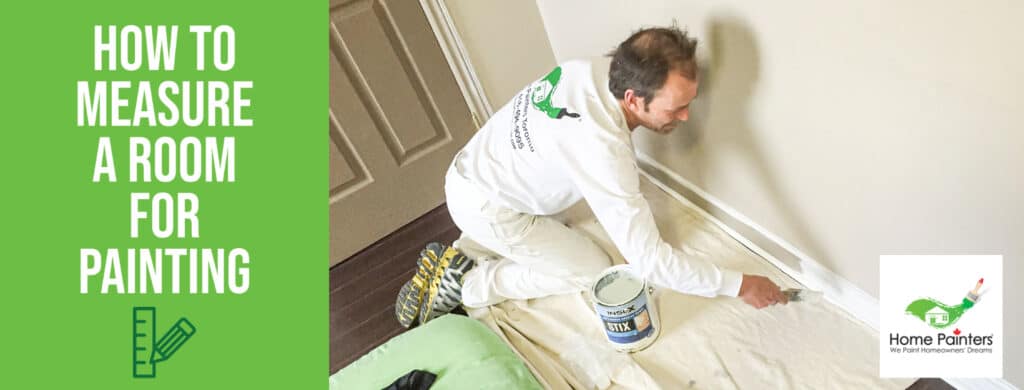
Before you start to paint your walls, you should know how to measure walls for paint first. You need to know how much paint you exactly need. A great way to determine how much paint you’ll need is by using Benjamin Moore’s paint calculator. If you are painting more than one room with the same colour, you need to add up the total square footage. In addition, these calculations are rough estimations. The exact paint you will need depends on multiple variations, including how you will be applying paint. The paint calculator only accounts for 2 coats of paint, minus the ceiling. I know homeowners want to know how much paint they will need and the proper measurements around their home. Measuring for accuracy is not as difficult as you think. Let’s discuss how to measure a room for painting!
Top Reasons for Accurately Measuring a Room Before Painting
Understanding the merits of precise room measurement before a painting project underscores its role as a cornerstone of effective project planning. Let’s delve into the key reasons why this step is non-negotiable.
1. Efficient Budgeting
By accurately measuring your room, you can estimate the amount of paint needed, helping you budget accordingly. Overestimating leads to unnecessary costs, while underestimating may result in additional trips to the store and hinder the continuity of your project.
2. Managed Expectations
A measured space offers an objective perspective of the painting situation, which paves the way for realistically assessing the timeline, labour, and resources needed. This can aid in preventing disappointments and recalibrations mid-project.
3. Consistent Quality
Understanding your room’s dimensions can help you deliver a consistent paint finish. Knowing the number of paint coats required, balancing wet edges, and avoiding paint accumulation at trims are some detailed elements better managed with a sound measurement in place.
4. Reduced Waste
An essential part of sustainability practices is reducing waste. Having a precise estimate of the paint needed prevents surplus, which is not only financially savvy but also earth-friendly.
5. Strategic Planning of Accent Walls or Patterns
Whether you are planning to incorporate accent walls or decorative patterns, such as stripes, stencil designs, or murals, precise room measurements will enable you to calculate and visualize the changes with greater confidence.
6. Account for Texture and Surface Porosity
Different wall textures and surface porosity can affect the amount of paint required. By comprehensively understanding the paint measurement unit of the room, you can factor in these variables and ensure you have the exact amount of paint to cover the walls adequately.
How to Measure Walls for Paint
When looking to measure a room for paint, there are many factors to consider. Each surface you want to paint has its own set of measurements (important to remember). Below is a list of things you’ll need to measure for better accuracy.
Walls
Lorem ipsum dolor sit amet, consectetur adipiscing elit. Ut elit tellus, luctus nec ullamcorper mattis, pulvinar dapibus leo.
Measuring Considerations
• Measure these separately from the walls
• Measure all types of trim found along the windows, doors, floor, etc.
Lorem ipsum dolor sit amet, consectetur adipiscing elit. Ut elit tellus, luctus nec ullamcorper mattis, pulvinar dapibus leo.
Measuring Considerations
Measuring Considerations
Walls
• In case there are differences, measure each wall in the room on its own
Baseboards & Trim
• Measure these separately from the walls
• Measure all types of trim found along the windows, doors, floor, etc.
Doors
• The door should be measured the same as a wall
• If your door(s) is not flat, you will need to make extra measurements to get the full square footage
Bathrooms
• Floors, ceilings, walls and trims should be measured the same way
• If you want to repaint surfaces (shower, sink, cabinets), they will need their own measurements
Kitchen
• Many surfaces can be measured, like the bathroom
• Every surface or appliance you want to paint, will need their own measurements for accuracy. For example, a pantry would need its own measurements
Basement
• Can be measured the same way as the above
• Some basements may be a little complicated to measure. In that case, break the floor/ceiling into sections, then add those measurements together
How to Measure a Room for Painting
When it comes to measuring surfaces in your home, the walls are the easiest. When you have your measuring tool and a calculator handy, you will be easily able to provide the most accurate measurements to paint a wall. Here are the steps on how to measure your walls:
- Find a measuring tool and measure the width of a wall (one end to another) in feet. Record the number, don’t forget it.
- Then with that same tool, measure the length of the wall (from floor to ceiling) in feet. Record the number, don’t forget it.
- Now, multiply both numbers together to get the square footage of the wall. This number will provide you a great paint quote.
- Repeat these steps for every wall you want to paint for your home.
BIG TIP: Don’t forget to measure the doors and windows! Very important!
If any of your walls have doors, windows, or other immovable surfaces that you don’t want to paint, subtract their square footage from that of the wall. This way, you can give your contractors accurate measurements. Multiply the length and width of your doors, windows, or anything on the wall that will not be painted to calculate these numbers.

\
Paint Your Walls in the Winter!
There are many benefits as to why you should paint your house in the winter. As a starter, most people are home, either for the holidays or because of the bad weather. More time at home means that you can finally get your home fixed and look stylish as ever. Although the temperatures are a little cooler in the winter months, there are benefits to painting during these times. One of them being that the temperatures not being too humid is a great thing. If it was extremely humid, the paint would dry too quickly. This is not good because the paint would not properly stick onto the surface. This could also cause peeling in the future and that can not happen! So cooler temperatures are a plus. Another benefit is that doing your interior painting during the fall and winter means you will be completely indoors. Of course, being outside is much more fun, but you could do all your outside chores during the warmer months.
Conclusion
Measuring a room for painting is a blend of art and science. While the process demands precision, it also requires you to envision the project’s outcome and prepare accordingly. Striking a balance between functionality, aesthetics, and cost-effectiveness begins here, with the first measurement you take. Armed with this guide, you’re well on your way to mastering the foundational step of any successful painting project.
Remember, every stroke of the brush is guided by the meticulous preparation you undertake now. So, measure twice, paint once, and watch as your space transforms.
More Interesting Blogs Related to
“How to Measure a Room for Painting”
If you reside in Toronto and the GTA and need some help figuring out the interior painting costs per square foot, don’t hesitate to call us! We will help you pick the colours you want and show you the latest painting and home renovation trends. Our home painting services with the best pro painters have been around now for over 36 years. Call 416.494.9095 or email Brian@HomePaintersToronto.com for a FREE quote for your home painting needs. And don’t forget to check us out on our social media channels below!





